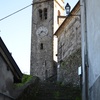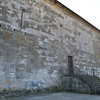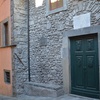Castle of Gallicano
The town of Gallicano is situated in the northern slope of Monte Gragno, along the path of the Turrite di Gallicano stream.
The Parish Church of San Jacopo, was built between the castle walls in the 15th century to replace the old parish church dedicated to Saint Cassiano and St. John the Baptist. The church, built in the Romanesque style with a single nave, conserves important sacred furnishings and works of art, including a wooden crucifix attributed to the Lucchese school and dating from the 14th century, a glazed terracotta altarpiece depicting the Madonna and Child with the Angels and Saints attributed to Andrea di Robbia of the early 16th century and a wooden statue of the Madonna and Child by Tino Camaino of the 14th century.
The Parochial Church of St. John the Baptist, a fine example of Renaissance art, was built in 1485 using materials from the old church of San Cassiano.
Inside is a wooden crucifix of the 14th-15th centuries and a 17th century Baptism of Christ, attributed to the Lucchese painter Pietro Paolini.
An image of the defences of Gallicano at the end of the 14th century is provided by an illustration from the chronicles of Giovanni Sercambi. In the depiction the castle consists of a fortress with a tall square tower, enriched with Guelph merlons, and a second small fortification, perhaps its antecedent indicated by various sources as a sturdy construction equipped with circular corner turrets and a square based tower. The structure underwent an evolution in the 18th century, the main addition being a stronghold on the outside of the upper walls. Of this complex system of fortifications only the bell-tower remains, an ancient structure that probably dates back to the first defensive system of the castle.
Historical notes
The fortress of Gallicano had been built before 1061 on the initiative either of the Bishop of Lucca, who could boast its possession, or by members of a branch of the Porcaresi family, who owned it until 1170, when the city of Lucca conquered the village and decided to raze every defensive structure to the ground.
During the 13th century a new castle was built in the same place, always on the initiative of feudal lords who, with the support of the imperial crown, tried to contend the jurisdiction of the City of Lucca in these mountainous lands.
We do not have much information about how the castle survived the struggles and unrest in the region during the 16th century.
Documentation of the Castrum, or Castle, of Gallicani was in the Golden Bull of the Emperor Charles IV, which confirmed the possession of the lands of the Garfagnana to the city of Lucca, suggesting that most of the Gallicanese defensive works were still in use.
Annexed to the House of Este in 1430, the community of Gallicano was occupied by the troops of Lucca in 1451, but was shortly re-conquered by the Duke Borso of Este. Only the intervention of Pope Nicholas V (1447-1455), to which the two contenders had appealed, managed to calm the situation by definitively assigning Gallicano to Lucca.











